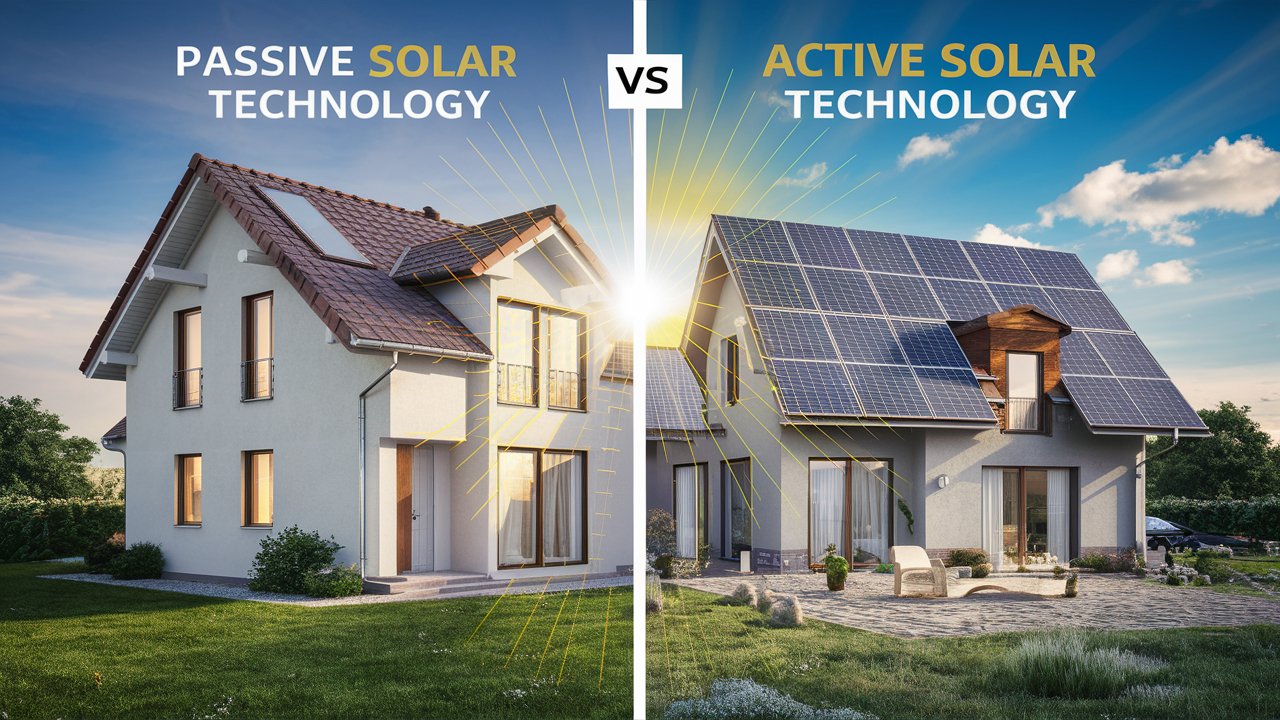Passive Solar vs. Active Solar: The Ultimate Showdown

Ladies and gentlemen, eco-warriors and energy enthusiasts, gather ’round for the solar showdown of the century! In the red corner, weighing in with zero moving parts and a design as old as the hills, we have the reigning champion of sustainable building – Passive Solar Technology! And in the blue corner, with its high-tech panels and fancy inverters, the poster child of renewable energy – Active Solar Systems!
Who will win this battle for the future of sustainable homes? Grab your popcorn (sun-popped, of course), and let’s dive into this electrifying match-up!
Round 1: The Basics – What’s What?
Passive Solar: This crafty contender uses the building itself to collect, store, and distribute solar energy. It’s like a cat lounging in a sunbeam – simple, effective, and no fuss.
Active Solar: This tech-savvy challenger uses external gadgets like solar panels, pumps, and fans to capture and move solar energy around. It’s more like a cat with a robot arm to adjust its sunbeam – more control, but also more complicated.
Round 2: The Pros – Why We Love Them
Passive Solar Pros:
- Cheaper to set up and maintain (more money for samosas!)
- No dependence on gadgets or electricity
- Blends seamlessly with your home’s design
- Lasts as long as your house does (which is hopefully a very long time)
- Works silently – no humming or buzzing
Active Solar Pros:
- Can be added to existing buildings (no need to rebuild your ancestral home)
- Gives you more control over energy collection and use
- Can generate electricity (hello, lower electricity bills!)
- Works well in a wider range of climates
- Can power your electric car (vrooooom!)
Round 3: The Cons – Nobody’s Perfect
Passive Solar Cons:
- Needs careful planning and the right location
- Performance can vary with the weather (just like our mood during monsoon season)
- Might limit some design choices
- Can’t generate electricity directly
Active Solar Cons:
- Costlier to install and maintain
- Relies on mechanical parts that can break down
- Might not blend in with traditional architecture (solar panels on a thatched cottage, anyone?)
- Requires regular cleaning and maintenance
- Performance can degrade over time
Round 4: Global Adaptability – From Arctic to Equator
Passive Solar: Passive solar shines (pun intended) in areas with big temperature swings between day and night. It’s like a chameleon, adapting to different climates with clever design tweaks:
- In cold climates like Canada or Norway, it maximizes sun exposure and heat retention.
- In hot, dry areas like parts of Australia or the Middle East, it focuses on shading and natural cooling.
- In tropical regions like Southeast Asia, it’s all about ventilation and managing humidity.
Active Solar: Active solar is more of a one-size-fits-all solution. As long as there’s sunlight, it can work (although efficiency varies):
- In sunny places like California or Spain, it’s a powerhouse of energy production.
- In cloudy areas like the UK or Seattle, it still works, just with lower output.
- In extreme climates like Alaska or Singapore, it can supplement other energy sources.
Round 5: Cost Comparison – Show Me the Money!
Passive Solar:
- Lower upfront costs (unless you’re doing a major renovation)
- Almost zero operating costs
- Savings on heating and cooling bills
- Potential for higher property value
Active Solar:
- Higher upfront costs for equipment and installation
- Some ongoing maintenance costs
- Potential for selling excess electricity back to the grid
- Savings on electricity bills
- Possible tax incentives or rebates (varies by country)
Round 6: Environmental Impact – Green vs. Greener
Passive Solar:
- Zero emissions during operation
- Uses mostly natural, often local materials
- Reduces overall energy consumption
- No electronic waste
Active Solar:
- Zero emissions during operation
- Produces clean electricity
- Reduces reliance on fossil fuels
- But… manufacturing and disposal of panels have some environmental impact
The Final Round: Which One Wins?
Ding ding ding! The judges’ scores are in, and… it’s a tie!
Wait, what? A tie?
That’s right, folks. In the world of sustainable living, there are no losers. In fact, the real winner is… drumroll, please… a combination of both!
The Perfect Tag Team: Passive Meets Active
Imagine a home with the thoughtful design of passive solar, working hand in hand with the electricity-generating power of active solar. It’s like combining the wisdom of your grandmother with the tech-savvy of your teenager – the best of both worlds!
Here’s how this dream team could work:
- Passive Solar Design: Your home is oriented to make the most of the sun’s warmth and light. It has thermal mass to store heat, excellent insulation, and clever shading.
- Active Solar Boost: Solar panels on the roof generate electricity for your appliances, with any excess fed back into the grid or stored in batteries.
- Smart Integration: A home energy management system optimizes the use of both passive and active solar features, ensuring maximum efficiency.
Global Success Stories: From Antarctica to the Sahara
This passive-active solar combo is winning fans all over the world:
- In Germany, the Passive House standard combines super-insulated passive solar design with active solar panels, creating homes that sometimes produce more energy than they use!
- In Australia, homes are using passive solar design to reduce cooling needs, while active solar panels take advantage of the abundant sunshine.
- In Canada, passive solar design helps homes stay warm in winter, while active solar panels provide electricity year-round, even with snow cover.
- In Japan, traditional concepts like the “engawa” (a sort of veranda) are being combined with modern solar technology to create homes that are both culturally resonant and super-efficient.
Your Solar-Powered Future: What’s Next?
So, what does this solar showdown mean for you, dear global citizen? Here are some takeaways:
- New Build? If you’re building a new home, consider incorporating passive solar design principles from the get-go. It’s easier and cheaper to build it right the first time!
- Existing Home? Look into adding some passive solar features during your next renovation. And consider if active solar panels might be a good fit for your roof and energy needs.
- Renting? You can still embrace the solar lifestyle! Use curtains and fans to manage heat and light, and talk to your landlord about the benefits of solar improvements.
- Community Action? Why stop at your own home? Consider advocating for solar-friendly policies in your community. From solar parks to passive solar design in public buildings, there’s plenty of room for sunshine in our shared spaces!
Remember, every little bit helps. Whether you’re designing a fully integrated passive-active solar home, or just being more mindful about opening and closing your curtains, you’re part of a global movement towards a more sustainable future.
So here’s to the sun – our oldest friend and newest ally in the quest for sustainable living. May your future be bright (but not too bright – don’t forget those passive solar shading devices!), your energy bills low, and your carbon footprint tiny.
The solar revolution is here, and guess what? You’re already part of it. Now go out there and let your solar flag fly!







